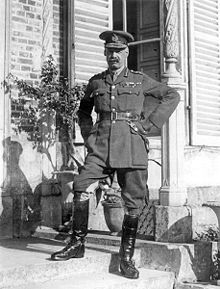Henry Rawlinson, 1st Baron Rawlinson

Henry Seymour Rawlinson, 1st Baron Rawlinson GCB , GCSI , GCVO , KCMG (born February 20, 1864 in Trent Manor, Dorset , † March 28, 1925 in Delhi ) was a British general in World War I and Commander- in -Chief in India .
Life
Rawlinson was born the son of the officer, orientalist and diplomat Sir Henry Creswicke Rawlinson , later 1st Baronet. After training at Eton and Sandhurst , he joined the King's Royal Rifle Corps as an officer in India in 1884 . He gained his first military experience under Lord Roberts during an uprising in Burma from 1886 to 1887.
In 1889 Rawlinson's mother died and he returned to England, where he transferred to the Coldstream Guards and was soon promoted to captain . During the advance on Omdurman in 1898, he served on the staff of Commander-in-Chief Herbert Kitchener . In the Second Boer War 1899-1902 he served with honors in a field command. In 1903 he became the commandant of Staff College .
After the outbreak of the First World War in August 1914, he was given command of the British IV Corps as Lieutenant General , with which he was supposed to support the Belgian army during the siege of Antwerp , but came too late. Rawlinson's corps was then involved in the First Battle of Flanders and various smaller offensives in 1915. At the end of 1915 he was appointed Commander in Chief of the 1st Army as the successor to Douglas Haig . In February 1916 he took over the newly established 4th Army , with which he played a leading role during the Battle of the Somme from July to November, which was extremely costly for both sides . In January 1917 he was promoted to general and subsequently charged with working out a plan for a combined sea / land operation against the Belgian coast, which was never carried out. In November of that year he took over command of the 2nd Army in place of Herbert Plumer, who had been transferred to the Italian front .
In February 1918 Rawlinson was appointed British representative to the Allied " Supreme War Council " in Versailles . In the following month he took over the newly formed 4th Army. This formed the spearhead of the Allied attack in the Battle of Amiens in August 1918 and thus heralded the hundred-day offensive that ultimately led to the defeat of Germany . In early September, Australian troops under Rawlinson's command broke through the German lines at Mont St. Quentin , near Péronne . In the middle of the month they reached in the Épehy area the apron of the German Siegfried position , which was also breached in the course of the battle of the Saint-Quentin Canal in early October.
After the armistice , the British Parliament passed a note of thanks to Rawlinson. In 1919 he was raised to the hereditary nobility of the Peerage of the United Kingdom as Baron Rawlinson , of Trent in the County of Dorset , and was awarded the Knight Grand Cross of the Order of Bath . In November 1919 he took over the command of the British Expeditionary Forces in Northern Russia from General Edmund Ironside in order to oversee their evacuation. He then received command of the Aldershot Command and was appointed Commander-in-Chief in India in 1920. He held the latter post until his death in 1925.
Rawlinson's younger brother Alfred played an important role as an intelligence agent in Persia, Mesopotamia, and the Caucasus during the First World War.
Rawlinson had no son, so the barony was extinguished on his death. The title of baronet , of North Walsham in the County of Norfolk , which he had inherited on the death of his father in 1895, passed to his younger brother.
literature
- Frederick Maurice (Ed.): The Life of General Lord Rawlinson of Trent, GCB, GCVO, GCSI, KCMG From His Journals and Letters. Cassell and Company Ltd, London et al. 1928.
- Robin Prior, Trevor Wilson: Command on the Western Front. The Military Career of Sir Henry Rawlinson 1914-1918. Pen & Sword Books, Barnsley 2004, ISBN 1-84415-103-4 .
- Rodney Atwood: General Lord Rawlinson. From Tragedy to Triumph , London: Bloomsbury 2020, ISBN 978-1-350-15113-0 .
Web links
- Biography on firstworldwar.com
- The Papers of General Lord (Henry S) Rawlinson Repository: Churchill Archives Center, Cambridge
- Newspaper article about Henry Rawlinson, 1st Baron Rawlinson in the 20th century press kit of the ZBW - Leibniz Information Center for Economics .
| predecessor | Office | successor |
|---|---|---|
| Herbert Miles | Commandant of Staff College Camberley 1903–1906 |
Henry Hughes Wilson |
| Charles Monro |
Commander in Chief of the British Armed Forces in India 1920–1925 |
Claud Jacob |
| Henry Rawlinson | Baronet, of North Walsham 1895-1925 |
Alfred Rawlinson |
| New title created | Baron Rawlinson 1919-1925 |
Title expired |
| personal data | |
|---|---|
| SURNAME | Rawlinson, Henry, 1st Baron Rawlinson |
| ALTERNATIVE NAMES | Rawlinson, Henry Seymour Rawlinson 1st Baron |
| BRIEF DESCRIPTION | British general |
| DATE OF BIRTH | February 20, 1864 |
| PLACE OF BIRTH | Trent Manor, Dorset |
| DATE OF DEATH | March 28, 1925 |
| Place of death | Delhi |
